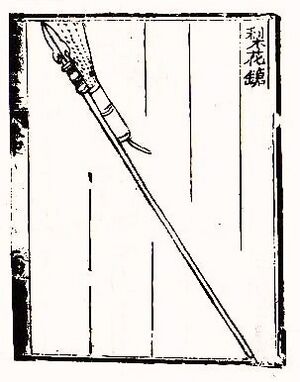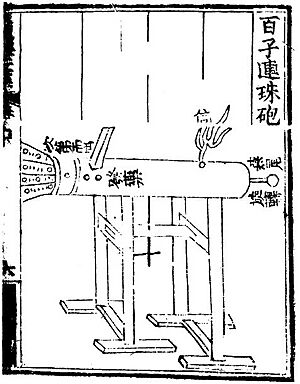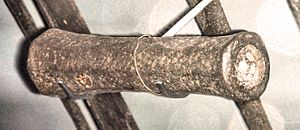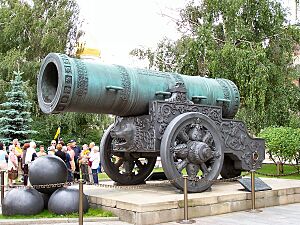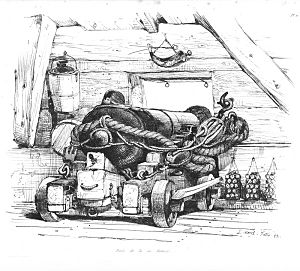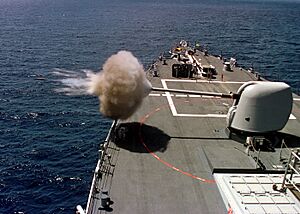History of cannons facts for kids
The history of cannons covers hundreds of years, from the 12th century to today. Cannons first appeared in China sometime between the 12th and 13th centuries. They likely grew out of an earlier gunpowder weapon called the fire lance. Cannons are cylinder-shaped weapons that fire projectiles using the explosive power of gunpowder. By the late 13th century, cannons were used in wars by the Yuan dynasty and then spread across Eurasia in the 14th century.
During the Middle Ages, both large and small cannons were made for sieges (attacking castles) and field battles. Cannons replaced older siege weapons like the trebuchet. After the Middle Ages, many large cannons were replaced by more numerous, lighter, and easier-to-move field artillery. New forts, like bastions and star forts, were built to better survive cannon attacks. Cannons also changed naval warfare, allowing ships to destroy each other from far away. As rifling (grooves inside the barrel) became common, cannons became much more accurate and deadly, especially for soldiers on foot. In World War I, most deaths were caused by cannons. They were also widely used in World War II. Most modern cannons are similar to those from World War II, including autocannons. However, naval guns are now much smaller.
Contents
How Cannons Developed in China
Cannons might have appeared in China as early as the 12th century. But they became more common in the 13th century. The cannon probably developed from the fire-lance. This was a 12th-century weapon that combined a gunpowder tube with a pole weapon.
From Fire Lance to Eruptor
Early fire lances were not true guns because they didn't shoot projectiles that filled the barrel. Later, things like iron scraps or porcelain pieces were added. Eventually, the paper and bamboo barrels of fire lances were replaced with metal. This made them stronger against the gunpowder's explosion.
In 1259, a "fire-emitting lance" (tuhuoqiang) appeared. It was a large bamboo tube filled with a "pellet wad." When fired, it shot the wad out, making a sound like a bomb. This pellet wad might have been the first true bullet.
These metal-barreled fire lances then became "eruptors" in the late 12th and early 13th centuries. These eruptors had different uses. Some shot poisonous gas and porcelain shards. Others shot sand and chemicals. More common ones, like the "phalanx-charging fire gourd," shot lead pellets. These eruptors were more like cannons but only fired shrapnel and shells.
The First Cannons
The oldest known picture of a cannon is a sculpture from the Dazu Rock Carvings in Sichuan, dated to 1128. It shows a figure holding a vase-shaped cannon, firing flames and a cannonball.
The oldest surviving gun with a production date is the Xanadu Gun, from 1298. Other cannons, like the Wuwei Bronze Cannon (1227) and the Heilongjiang hand cannon (1288), might be even older. The Wuwei Bronze Cannon was found in 1980. It's a 100-centimeter, 108-kilogram bronze cannon. It might be the oldest and largest cannon from the 13th century.
Cannons were used in battles like the Red Turban Rebellion. During the Siege of Shaoxing (1358–9), defenders used "fire tubes" to stop attackers. In 1363, Chen Youliang failed to capture Nanchang because of the defenders' cannons.
Cannons were also used on ships. In the Battle of Lake Poyang in 1363, Zhu Yuanzhang's fleet had "fire bombs, fire guns, fire arrows." While guns were used, fire bombs thrown by ship-mounted trebuchets were key to burning enemy ships.
After winning battles, the Hongwu Emperor created a Bureau of Armaments. It made thousands of bronze handguns, signal cannons, and ammunition. Other firearms like "miraculous [fire] lances" and "miraculous guns" were also made.
In 1388, cannons were used successfully against war elephants in the Ming–Mong Mao War (1386–1388). In 1414, the Ming army used guns to scare away an Oirat force.
Early Ming cannons included the "crouching tiger cannon," a small cannon with legs for support. The "awe-inspiring long range cannon" was a medium-sized cannon with a sight. Larger cannons, like the "great general" and "great divine cannon," were also developed. The "great general cannon" weighed up to 360 kilograms and fired a 4.8-kilogram lead ball. The "great divine cannon" could weigh up to 600 kilograms and fire many iron balls at once. These were the last Chinese cannon designs before European models arrived in the 16th century.
Cannons Spread Around the World
Medieval Europe
The first known European picture of a cannon appeared in a manuscript by Walter de Milemete in 1326. It shows a cannon firing a large arrow. On February 11, 1326, the city of Florence ordered metal cannons for defense.
These early cannons were used by both the French and English during the Hundred Years' War. This was when cannons first saw real use in European battles. By 1350, the writer Petrarch noted that cannons were "as common and familiar as other kinds of arms."
Cannons appeared in Russia around 1380, mainly for defending cities. The Byzantine Empire also started getting cannons to fight the Ottoman Empire. The first clear use of cannons in the region was against the Ottoman siege of Constantinople in 1396.
The Ottomans later got their own cannons. In 1422, they besieged Constantinople again using "falcons," which were short, wide cannons. A Hungarian engineer named Orban helped the Ottomans build a massive cannon called "Basilica." It was 27 feet long and could throw a 600-pound stone ball over a mile. This gun was very difficult to move and fire.
During the Siege of Constantinople (1453), the Ottomans used dozens of large cannons and 500 smaller ones. They bombarded Constantinople's walls for 55 days. The stone cannonballs hit the walls with huge force, knocking them down. The city's defenses were eventually broken, and the Ottomans won the siege.
Southeast Asia
Mongol troops brought Chinese cannons to Java during their 1293 invasion. The Ayutthaya Kingdom used cannons in 1352 when they invaded the Khmer Empire. Within ten years, the Khmer Empire had a lot of gunpowder.
Vietnam's Lý dynasty used gunpowder weapons like the fire arrow during the Lý–Song War (1075 – 1077). In 1390, the King of Champa and his army were killed by cannons from Vietnamese prince Trần Khát Chân.
When the Portuguese arrived in Malacca in 1509, they found Javanese merchants making their own cannons. By the early 16th century, the Javanese were making large guns locally. Some of these "sacred cannons" still exist today. They weighed between 3 and 8 tons and were 3 to 6 meters long.
Islamic World
Historians debate exactly when cannons first appeared in the Islamic world. Some sources suggest the Mamluks used cannons against the Mongols in 1260 at the Battle of Ain Jalut. However, other historians believe cannons reached Mamluk Egypt later, around the 1370s.
It's not certain when the Ottomans started using firearms. But they likely used cannons by the 1420s. Very large cannons were used by the troops of Mehmed II to capture Constantinople in 1453.
The Dardanelles Gun, made in 1464, weighed 18.4 tons. It was still used over 300 years later in 1807. Turkish forces fired it at British ships, killing 28 sailors.
East Asia (Korea and Japan)
Korea started making gunpowder in 1374. They used cannons against Japanese pirates by the 1380s. By 1410, 160 Korean ships reportedly had some kind of artillery. They used mortars that fired "thunder-crash bombs" and four types of cannons. These cannons usually shot wooden arrows with iron tips, but sometimes stone and iron balls.
Firearms were known in Japan around 1270 as "teppō" (iron cannon). But gunpowder weapons spread slowly to Japan. The first recorded cannon in Japan was in 1510. A Buddhist monk brought an iron cannon from China. Firearms were not widely used in Japan until Portuguese matchlocks were introduced in 1543.
Early Modern Cannons
By the 16th century, cannons came in many sizes. Generally, longer barrels meant longer range. Some cannons were over 10 feet long and weighed up to 20,000 pounds. They needed a lot of gunpowder to fire stone balls hundreds of yards.
European rulers began to classify cannons to reduce confusion. Henry II of France chose six sizes. Better gunpowder was also developed. Instead of fine powder, a "corned" (coarse grain) powder was used. This allowed the fire to spread faster and more evenly.
Cannons led to the decline of older siege engines like siege towers and trebuchets. Castles were not immediately useless, but their importance in battle quickly dropped. New fortresses had thicker, angled, and sloped walls. Towers became lower and stronger. These new defenses were called "star forts" because of their shape.
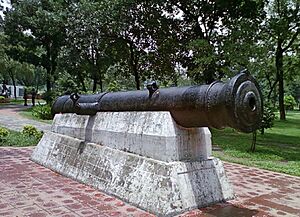
By the late 15th century, cannons became more mobile. Wheeled gun carriages and trunnions (pivots) became common. The invention of the limber (a two-wheeled cart for the front of the gun) made transporting artillery even easier. This made field artillery practical. Better gunpowder, improved cast-iron projectiles, and standard sizes meant even lighter cannons could be deadly.
Innovations continued, like the German invention of the mortar. This was a thick-walled, short-barreled gun that fired shots upward at a steep angle. Mortars were useful for sieges because they could fire over walls. The Dutch learned to shoot bombs filled with powder from them.
Gustavus Adolphus of Sweden focused on using light cannons and making his army more mobile. He created new formations and tactics for artillery. He stopped using cannons heavier than 12 pounds as field artillery. Instead, he preferred cannons that only needed a few men to operate. His army was the first to use a special cartridge with both powder and shot. This sped up loading and increased the firing rate. He also pioneered the use of canister shot (a can filled with musket balls) against infantry.
At the Battle of Breitenfeld (1631), Adolphus showed how effective his changes were. His army fired three to five times more artillery volleys than the enemy. This battered the enemy, causing them to break ranks and flee.
Around this time, gunners also started aiming cannons to hit targets. They used a "gunner's quadrant" to measure the angle of elevation. But cannons didn't have sights, so aiming was still mostly guesswork.
In the late 17th century, the French engineer Vauban introduced a more scientific way to attack forts. He also built many star forts and popularized the idea of "depth defense" against cannons.
Cannons in the 18th and 19th Centuries
The lower decks of 17th-century English ships of the line often had demi-cannons. These guns fired a 32-pound solid shot and weighed up to 3,400 pounds. They could penetrate over a meter of solid oak from 90 meters away. Full cannons fired a 42-pound shot but were too heavy and were stopped by the 18th century.
The carronade was adopted by the Royal Navy in 1779. It fired a round shot with lower muzzle velocity. This was meant to create more deadly wooden splinters when hitting enemy ships. The carronade was much shorter and weighed a third to a quarter less than a similar long gun. This made them easier to handle and they needed less gunpowder and fewer crew members.
In the 1810s and 1820s, accuracy at long range became more important. The carronade, despite its early success, disappeared from the Royal Navy by the 1850s. However, carronades were still used in the American Civil War.
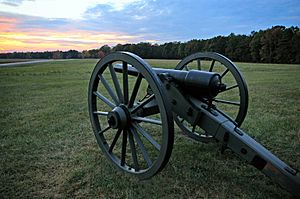
In contrast to old weapons, Western cannons in the 19th century became larger, more destructive, more accurate, and had longer ranges. For example, the American 3-inch wrought-iron howitzer used in the American Civil War had an effective range of over 1.1 miles. The smoothbore 12-pounder Napoleon was known for being sturdy, reliable, and having a range of 1,700 meters.
Cannons were vital to Napoleon Bonaparte's rise to power. During the French Revolution, Napoleon used cannons to fire grapeshot into a mob attacking Paris. This event, known as the "whiff of grapeshot," ended the threat to the new government and made Napoleon famous. Napoleon often gathered his cannons into large groups and improved French artillery. This helped the French win battles, like at Battle of Friedland, where 66 guns fired thousands of shots, causing huge losses for the Russians.
At the Battle of Waterloo, Napoleon's final battle, the French army had many more cannons than the British or Prussians. The muddy battlefield made cannons sink after firing, slowing down their rate of fire. Despite this, the artillery fire was deadly, especially during the French cavalry attack.
The practice of rifling (adding spiraling grooves inside the barrel) became more common by 1855. This gave cannon projectiles gyroscopic stability, improving accuracy. One of the first rifled cannons was the Armstrong gun. It had much better range, accuracy, and power. The Armstrong gun's projectile could reportedly pierce a ship's side and explode inside.
The superior cannons of Western countries gave them huge advantages in warfare. In the Opium War in China, British battleships bombarded coastal areas from afar, safe from Chinese cannons. The shortest war in history, the Anglo-Zanzibar War of 1896, ended quickly due to shelling from British battleships. The term cannon fodder came from the idea of soldiers being just "food for powder" in the face of powerful artillery.
Cannons in the 20th and 21st Centuries
Modern cannons are usually divided into types like howitzers, mortars, guns, and autocannons. Artillery's main job is to provide fire support. This means using fire to destroy, disable, or suppress the enemy, working with troop movements.
In military terms, a "gun" is a cannon with a high muzzle velocity and a flat trajectory. This is different from howitzers or mortars, which have lower muzzle velocities and usually fire indirectly (over obstacles).
Artillery
By the early 20th century, infantry weapons became more powerful. This pushed most artillery away from the front lines. Even with indirect fire, cannons were very effective in World War I, causing over 75% of casualties. Trench warfare increased the need for howitzers. They fired at a steep angle, making them better at hitting targets in trenches. Their shells also carried more explosives. World War I also saw the use of the Paris Gun, the longest-ranged gun ever fired. This 200 mm gun was used by Germans to bombard Paris from over 122 km away.

World War II brought new cannon technology. These included sabot rounds (projectiles with a discardable casing), hollow-charge projectiles, and proximity fuses (which explode near a target). The German 88 mm gun became famous for its effectiveness against Allied tanks. Proximity fuses were very effective against German soldiers in the open during the Battle of the Bulge. They were also used in anti-aircraft projectiles against V-1 flying bombs and kamikaze planes. Anti-tank guns also improved greatly during the war.
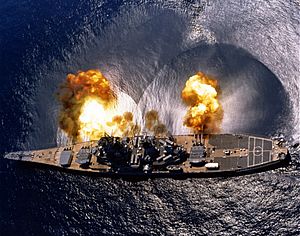
Howitzers can also fire directly, even though they are designed for steep angles. This happened during the Korean War at the Battle of Chosin Reservoir. Two field batteries fired directly at Chinese infantry, causing heavy casualties.
In recent years, the trend of making larger cannons has reversed. The United States Army sought lighter howitzers. The M198 howitzer was chosen in 1979. It is now being replaced by the M777 Ultralightweight howitzer, which weighs almost half as much and can be carried by helicopter. Naval guns are also smaller now, and sometimes replaced by cruise missiles. However, new destroyers like the Zumwalt-class destroyer will have a powerful Advanced Gun System (AGS). These 155 mm guns can fire rocket-assisted projectiles over 100 km. They will be water-cooled and can fire 10 rounds per minute per gun.
Autocannon
An autocannon is a cannon with a larger caliber than a machine gun but smaller than a field gun. Autocannons load ammunition automatically, so they fire much faster than artillery. Their minimum bore size has been 20 mm since World War II.
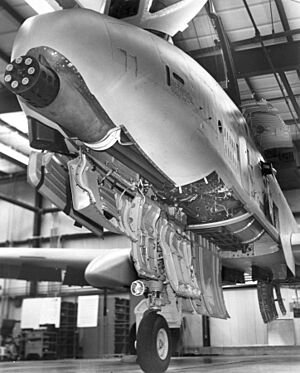
Most nations use these rapid-fire cannons on light vehicles. A common autocannon is the 25 mm "Bushmaster" chain gun, found on vehicles like the LAV-25 and M2 Bradley.
Autocannons have largely replaced machine guns in aircraft because they have greater firepower. The first airborne cannons appeared in World War II. They were heavier than machine guns, so planes could only carry one or two. However, cannons were more effective against armored bomber aircraft. Nearly all modern fighter aircraft have an autocannon. The largest and most powerful airborne cannon used by the military of the United States is the GAU-8/A Avenger Gatling-type rotary cannon.
Autocannons can fire many rounds quickly, but they are limited by how much ammunition they can carry. For this reason, some autocannons are designed with slower firing rates to save ammunition. Modern autocannons fire from 90 to 1,800 rounds per minute. Multi-barrel Gatling guns can fire several thousand rounds per minute. The fastest, the GSh-6-30K, fires over 6,000 rounds per minute.


